TheRoundup is reader supported. We may earn a small commission when you make a purchase via links on this site, at no cost to you.
All products are personally reviewed and tested in accordance with our Review Methodology.

Nonstick pots and pans certainly make cooking and cleaning easier. In fact, more than 200 million of them are sold globally each year.
But could your cookware be harming your health?
Traditional cookware could contain a potentially toxic mix of lead, cadmium, PFOA, PTFE (Teflon), PFAS, and other forever chemicals that can leach into your food.
Because I'm a keen (and occasionally good) home cook, I recognize the importance of quality kitchenware. So my family and I set out to test and research the best non-toxic cookware for you and the planet.
We tested everything from shiny stainless steel pots to super durable cast iron cookware to compile this list of the safest cookware brands of 2024.

✔ Ethical Manufacturing
✔ Versatile & Multi-Purpose Designs
✔ Wide Range of Non-Toxic Products
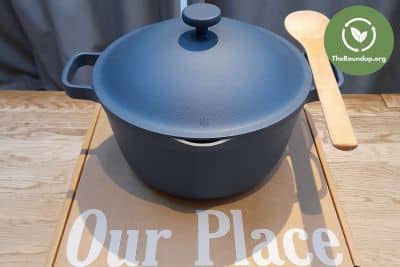
Why It's My #1 Pick: I chose Our Place as the non-toxic cookware option overall because the range of cookware (and other products) available is far greater than most of the other brands I tested.
I love how each item is made using responsibly sourced materials and comes with complete supply chain transparency, which is rare in the cookware industry.
Personal Experience: My entire family and I are big fans of Our Place. From dinnerware to an air fryer (and everything in between), we use at least one of their products every day (I'm currently sipping green tea from an Our Place day mug!).
The Always Pan and Perfect Pot are two of the most indispensable pieces in my kitchen. I like the blend of looks, sustainability, practicality, and attention to detail.
Every Our Place product I've tested has shipped to me in packaging that looks and feels premium but is sustainable. A big standout for me is the use of recycled and recyclable cardboard. It retains its shape and protects the item inside without using glue, staples, or tape...neat!
Check out my detailed Our Place review for a full breakdown of all the Our Place products I've tested and recommended.
About the Brand: Our Place is based in Los Angeles. The products are made in China, but the brand does at least verify that the partners it uses are sustainable and ethical.
The brand has successfully created a line of cookware that looks good and promotes healthier cooking practices.

✔ Free from Toxic Chemicals
✔ Sustainable Packaging & Ethical Manufacturing
✔ Low Maintenance
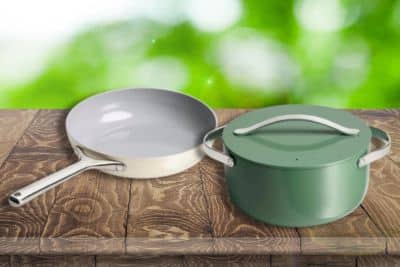
Why It's the Best Nonstick Ceramic Option: I feel Our Place currently has the edge regarding the range of products available and overall brand quality. However, during my testing, I felt that the nonstick surface on the Caraway cookware performed slightly better than Our Place.
Personal Experience: Immediately after unboxing the Caraway Cookware & Minis Set, I first noticed the excellent build quality. It felt sturdy and lightweight with a classy modern design.
On closer inspection of the brand and a detailed test of its best-selling Cookware & Minis Set, I found the non-toxic, nonstick coating on the Caraway cookware to be super slippy and great at releasing food at low and medium temperatures (high-temperature cooking is not recommended with ceramic cookware).
From a morning omelet to a lightly simmered tomato sauce, I found that everything I tested cooked evenly. I also found them incredibly easy to clean. A quick dunk in hot, soapy water made these pans spotlessly clean again.
I'm very particular about organizing the pots and pans in my kitchen. So, I was delighted to discover that the Cookware & Minis Set from Caraway comes with a neat storage solution. It helped keep my testing cupboard organized and prevented the cookware from getting damaged.
About the Brand: Caraway's makes its products in ethically managed factories in China. The use of BSCI and SMETA-certified manufacturing gives me peace of mind that every piece in the Caraway range meets strict ethical labor practices.

✔ Made in the USA
✔ Retains More Nutrients in Food
✔ Surgical Grade Stainless Steel
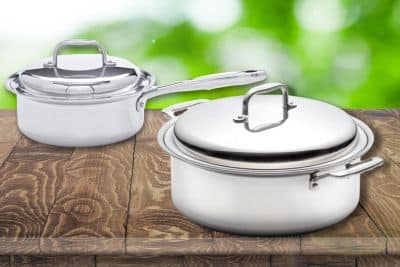
Why It's Best for Induction Stoves: 360 Cookware's incredibly energy-efficient and quick heat-up times (especially when boiling water) made it the best induction stove option I tested.
The surgical-grade stainless steel construction and super smooth base also suited the glass surface of my induction stove. Zero scratches during testing kept me in Mrs. Miller's good books!
Personal Experience: I was blown away by how quickly these pans heated up during testing. The aluminum core sandwiched between layers of stainless steel enhances heat conductivity. This gave me an even heat distribution with no hot spots.
360 Cookware uses a thicker gauge of steel than most of the other stainless steel brands I tested.
The seal created by the Vapor® technology locks in extra heat and also allows me to cook vegetables and proteins without added fats or oils while preserving their natural flavors and nutrients. I try to run a healthy kitchen so this was a standout feature for me.
360 Cookware is very shiny, and I like that look. However, it does show fingerprints and scratches easily. If you buy this cookware, a small amount of extra care will be needed to keep it in A1 condition.
That said, if you invest in 360 Cookware and give it the love and care it deserves, I do not doubt it will last you a lifetime. I guess that's why it comes with a lifetime guarantee!
About the Brand: 360 Cookware is Handcrafted in the US. Every piece is produced with attention to environmental impact, worker safety, and product longevity.
In fact, the company's manufacturing techniques are so refined that they require zero EPA permits...impressive!
The factory operates with a veteran workforce sharing over 400 years of combined experience in cookware manufacturing.

✔ Superior Heat Retention
✔ Versatile and Durable
✔ Easy to Clean and Maintain
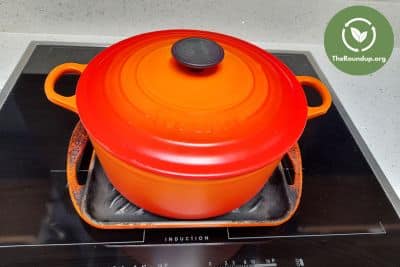
Why It's Best for Gas Stoves: Le Creuset cookware is incredibly durable and deals with the heat of a gas stove better than some of the cheaper cast iron brands I tested.
I found that its heavy-duty construction also minimized hot spots better than the competition, so my food cooked more evenly.
Personal Experience: Thanks to my super chef Mom, I grew up being taught how to cook with Le Creuset on a gas stove. The Dutch Oven and Grill Pan I use at least once a week was a present given to me by my parents over a decade ago.
I love how Le Creuset cookware heats quickly and retains the heat for a long time. This means I can turn down the heat to save energy while still achieving the perfect cooking temperature.
I also love the versatility of my Dutch Oven and Grill Pan. I feel Le Creuset products work best on a gas stove, but they also perform brilliantly on my induction stove.
The Dutch Oven is perfect for stove-to-oven recipes (such as Mrs. Miller's beef stew and dumplings).
But my Grill Pan is my personal favorite. I like to get it smoking hot to sear a steak and char some asparagus as an occasional weekend treat! ????
Le Creuset cookware is dishwasher safe. However, I usually hand wash mine to prolong its life.
About the Brand: Founded in 1925 in France, Le Creuset has established itself as a leader in high-quality cookware. The brand is renowned for its vibrant, chip-resistant enameled cast iron.
Each piece of Le Creuset cookware is cast from a unique sand mold and hand-finished by skilled artisans. The brand's commitment to craftsmanship produces a level of detail and quality that few can match.

✔ Non-Reactive and Stain-Resistant
✔ Sleek Modern Design (Doubles as Serveware)
✔ Can Tolerate Extreme Heat
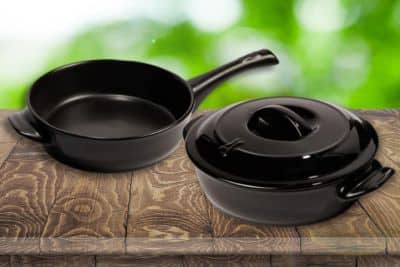
Why It's Best for High Heat and Open Fires: Xtrema cookware is made entirely from natural ceramic and designed to withstand extreme temperatures. When tested at the hottest temperature or over an open fire, it outperformed all other cookware.
Personal Experience: I was impressed with Xtrema when I tested and recommended its retro tea kettle and was keen to test other products in the range.
I tested the Signature Series Set. The set's versatility impressed me across various cooking challenges (from searing meats to simmering stews and baking desserts). Each challenge was met with outstanding results that showed excellent heat management and retention.
Xtrema cookware did not work on my induction stove, so I had to test it on a friend's gas stove.
What I love about Xtrema cookware is its resistance to extreme heat. I tested this when I used the Versa Pan to make huevos rancheros over an open fire for a lazy Sunday brunch. It passed with flying colors and looked as good as new after a wash in hot, soapy water.
About the Brand: Xtrema Cookware is produced by Ceramcor, a company that specializes exclusively in ceramic cookware.
Xtrema's cookware is made by skilled artisans in China, from a blend of natural clay and water. It's then triple-fired at 2,500° F to create a durable, highly resistant finish.

✔ Hand-Hammered by Skilled Artisans
✔ Designed to Last for Generations
✔ Precise Cooking Control

Why It's the Best Copper Cookware: Sertodo Copper's cookware was the most luxurious of all the brands I tested. It's the perfect choice if you have a large budget and are looking for exceptional artisan quality.
Personal Experience: I tested the Sertodo Copper 3 Qt Fry Pan and found it to be an absolute beauty. From the moment I unboxed it, it was clear that this pan had been made with care and precision.
Cooking with this pan was as enjoyable as looking at it. It heated quickly and evenly and was perfect for searing meats and sautéing vegetables. The tin-lined interior is a naturally nonstick surface. However, it's not as slippery as other options in this article (Our Place and Caraway, in particular).
I also really like the handle of this pan. It's such a clever design that's pleasing to look at, stays cool, and also acts as a spoon rest.
About the Brand: Founded in 1997, Sertodo Copper is an international cooperative with artisan workshops in Austin, Texas, and Santa Clara del Cobre, Michoacan, Mexico (a region with a rich thousand-year history in copper craftsmanship).
The brand's commitment to sustainability is evident in its use of 100% recycled copper. It appeals to the eco-conscious consumer in me and helps provide superior heat conductivity.

✔ Used in Michelin-Starred Kitchens
✔ Lifetime Warranty
✔ Exceptional French Quality

Why It's the Best Carbon Steel Option Made In got the nod ahead of other carbon steel brands I tested because of the exceptional quality of the blue carbon steel used.
The hybrid nature of Made In carbon steel cookware blends the heat retention abilities of cast iron with the lighter, quicker-reacting qualities of stainless steel. This resulted in quick heat-up times and excellent heat retention during testing.
Personal Experience: I was very impressed with the 12" Blue Carbon Steel Wok. When cooking a high-heat, fast-paced stir fry, the ingredients cooked more evenly and quickly than any other woks I tested.
This Made-In wok also felt very comfortable in my hand, allowing for effortless, quick tossing of the food.
I also tested the wok's versatility by steaming fish. The results were outstanding. The fish was perfectly cooked and retained its delicate flavors.
I found that once properly seasoned (and cared for), Made In's carbon steel cookware offered an excellent level of natural nonstick. This is essential for authentic stir-fry techniques that require high temperatures to achieve wok hei.
About the Brand: Made In has used its deep industry knowledge and relationships to produce cookware that meets the needs of both professional chefs and home cooks.
A lifetime warranty underscores the brand's commitment to quality and durability. I also love the dedication to sustainability shown by the Made In cookware recycling program.
I tested a wide range of cookware to compile this article's list of high-quality recommendations.
Here's how I scrutinized each piece, from skillets to saucepans, so you can be sure you're getting the very best product for your hard-earned buck.
I prioritized the least toxic pots and pans, made from materials known for sustainability, safety, and lack of harmful chemicals (more on these later).
Good cookware should do more than look pretty on the stove. It needs to perform well.
I tested how evenly each piece distributed heat, how well it retained heat, and whether it could sear a steak or gently simmer a sauce without scorching.
I also looked for natural nonstick capabilities (such as well-seasoned cast iron or slippy ceramic) and tested stovetop compatibility (especially with induction stoves).
I checked how easy each item was to care for.
The simpler, the better because you don't want to spend more time scrubbing pots than cooking with them.
You don't want to replace your cookware every few years, so I looked for signs of quality construction and durability.
Handles should be securely attached, and materials should be strong enough to resist warping and wear over time.
I assessed whether the cookware offered good value for money.
This doesn't always mean cheap. Instead, it's about balancing cost with features like longevity, performance, and health benefits.
We all like a bit of style in our eco-kitchen.
So, I evaluated the design and visual appeal of each piece of non-toxic cookware I tested.
I'm not the only voice that matters here. I dug into what other users were saying.
Customer reviews can highlight issues that might not be apparent in my testing process.
If there's a pattern of complaints or praises, it helps inform the overall recommendation.
A robust warranty usually shows the manufacturer's confidence in its product.
I checked the length and terms of each warranty to ensure it covers potential defects or problems that might arise from normal use.
How the product arrives at your doorstep is part of the experience.
I evaluated the packaging for eco-friendliness and the care taken to prevent damage during shipping.
Any brands offering carbon offsetting of the impact of the shipping process received bonus points.
Although I have a preference for products made locally, it's a fact that many of the leading non toxic cookware brands manufacture their products in China.
I appreciate this is not ideal because of the shipping footprint, and also because of issues with supply chain transparency. So I only recommended products made with strict environmental and labor regulations, supporting fair practices and sustainable manufacturing.
Non-toxic cookware doesn't leach harmful chemicals, helping to keep meals clean and the body free from unwanted toxins.
Non-toxic cookware is generally more eco-friendly to produce and dispose of than mainstream cookware.
By choosing cookware made from durable and recyclable materials, you're helping reduce waste and energy consumption.
Using long-lasting cookware also means fewer replacements, saving more resources and money.
Teflon, the brand name for polytetrafluoroethylene (PTFE), has been the go-to for non-stick cookware for a long time.
However, when overheated, Teflon cookware releases toxic fumes that can cause symptoms often called Teflon flu or polymer fume fever.
Have you ever encountered the term forever chemicals? That's a nickname for per- and polyfluoroalkyl substances, or PFAS for short.
These synthetic chemicals are found in various consumer goods, including the nonstick coatings often used in cookware.
PFAS has been linked with various negative health impacts, including changes in birth weight, thyroid problems, and high cholesterol.
Previously used in the manufacturing of Teflon, PFOA has been mostly phased out due to links to various health issues.
While it's less common now, older products might still pose risks.
Aluminum is a kitchen favorite because it's lightweight and great for even heat distribution.
However, if it's not treated or coated properly (common with cheap and poorly made cookware), it can react with acidic foods. This can result in a metallic taste and the potential for toxins to leach into your food.
Poor-quality stainless steel cookware leaches nickel and chromium into food (especially under high temperatures and when exposed to acidic foods).
Choosing high-quality stainless steel will prevent leaching.
Found in some ceramic glazes and decorations, these heavy metals can leach into food.
Lead exposure, even at low levels, can affect the nervous system, while cadmium can lead to kidney damage.
The FDA monitors these substances in cookware, but it's best to ensure ceramics are labeled lead-free and cadmium-free.
Ceramic cookware is made from clay and kiln-baked to high temperatures. It often features a natural, nonstick surface without synthetic coatings.
Pros:
Cons:
Cast iron is one of the oldest cooking materials. It offers durability and excellent heat retention.
Pros:
Cons:
Stainless steel cookware is made from an alloy containing chromium and nickel.
Choosing cookware made from high-quality stainless steel is essential to avoid the leaching mentioned earlier.
The two common non-toxic stainless steel options are as follows:
Pros:
Cons:
Glass cookware is made from tempered or borosilicate glass, which can withstand high temperatures without releasing toxins.
It's considered one of the safest cooking materials. However, it's much more commonly used in bakeware than in pots and pans.
Pros:
Cons:
Copper is a highly conductive metal, making it excellent for precise temperature control.
It's typically lined with stainless steel or tin to prevent copper from leaching into food. However, some people like using 100% copper cookware and drinkware because of the potential health benefits of copper in Ayurveda holistic medicine.
Pros:
Cons:
Like cast iron, carbon steel is made primarily from iron and carbon but in different proportions, making it lighter and more responsive to temperature changes.
It's popular in Asian cooking (especially woks), where food is cooked quickly at high temperatures.
Pros:
Cons:
Titanium is used in high-end and professional cookware due to its strength, lightweight, and corrosion resistance.
Pros:
Cons:
With proper care and maintenance, you can significantly extend the life of your cookware and help preserve its non-toxic properties.
Here are a few tips to help you keep your eco-friendly pots and pans in top shape, ensuring they remain safe and effective for years to come.
No, Le Creuset cookware is non toxic. It uses a high-quality coating that is safe for everyday cooking. While Le Creuset's nonstick coating does contain chemicals from the PFAS family, the levels are significantly lower than that found in traditional cookware options.
Yes, enameled cast iron is generally safer than traditional nonstick cookware. Enameled cast iron provides a nonstick surface without the use of chemical coatings.
Cookware that includes PTFE (also known by the brand name Teflon) may contain forever chemicals.
It's unlikely you can recycle your cookware with your curbside collections. However, there are still plenty of ways to recycle or reuse old cookware responsibly.
Nanoparticles in cookware refer to extremely small particles, typically ranging from 1 to 100 nanometers in size, that enhance certain properties of cookware materials.
Some low-quality ceramic pans use titanium dioxide nanoparticles for a non-stick effect. These particles can leach into your food, especially if the pan becomes scratched.
The best way to reduce chemical exposure when using Teflon pans is to stop using them. If this isn't possible, the following will help reduce your exposure:
My research and testing have shown me that ditching cheap and potentially toxic cookware for durable, long-lasting, non-toxic cookware is a no-brainer.
Yes, it's an expensive initial outlay. But, if you buy high-quality and non-toxic pots and pans (such as my beautifully functional #1 pick, Our Place), you're treating yourself to years of home-cooked meals without a side of chemicals!
Each recommendation in this article has something to offer ethical and eco-conscious consumers.
From high-heat-loving pure ceramic to high-maintenance but gorgeous copper, you're sure to find the perfect non-toxic cookware for your chemical-free kitchen.
What's your favorite material to cook with? Have I missed your favorite cookware set brand? Drop me a line and let me know.

Our core values mean we always prioritize sustainability over profit. We carefully evaluate and personally test every product to ensure they meet our high standards. All products recommended in this article were tested in accordance with our Review Methodology.
TheRoundup.org - As Seen On
